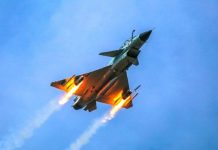China remains the biggest arms exporter to Pakistan. According to a report by RAND, Pakistan accounts for nearly 42% of China’s total arms sales. On the contrary, Pakistan’s arch-enemy India remains the biggest economic partner of China in the region with bilateral trade expected to touch $100 Billion.
- China Assures “Armed Drones Deal With Pakistan” Not Against India
- Israel Concerned By Russian Aggression in the Lucrative Indian Defence Market?
China has emerged as a key supplier of major weapons to South Asian countries especially Pakistan and Bangladesh. Sales to both the nations amount to over 53% total Chinese arms sales between 2000-14.
The most notable Chinese sale Pakistan was of JF-17 fighters followed by an agreement to build the fighter jets in Pakistan under a joint venture.
China has continued to provide significant defence assistance to Pakistan including assisting develop the country’s nuclear program. During the mid-1970s Beijing covertly assisted Islamabad’s nuclear ambitions to counter New Delhi, according to the RAND report.
“In 1988, China agreed to supply and train Pakistanis to operate the M-11 solid-fuel rocket, with a 185-mile range and carrying a 1,100-pound warhead. In succeeding decades, China has sold Pakistan hundreds of fighter jets and signed agreements to sell frigates and submarines to Pakistan,” the report read.
China maintains strong defence ties with Pakistan and it is to check what Islamabad states as Indian belligerence. of late. According to the document, close ties with Pakistan, “the linchpin of China’s South Asia policy”, are based on three factors: ensuring China’s internal stability, balance against India and defending China’s growing economic interests.
At the same time, China-India economic ties are soaring at a rapid pace. India is China’s largest trading partner in the region and the bilateral trade between 2000 and 2013 was estimated to be at $65 billion (compared to a modest $14 billion between China and Pakistan). By 2020, India-China trade volume is widely speculated to touch magical $100 Billion.
Other News at EurAsian Times




